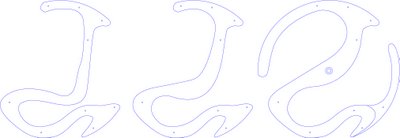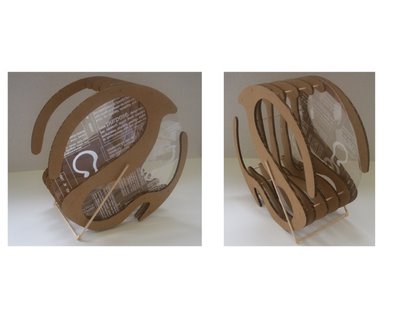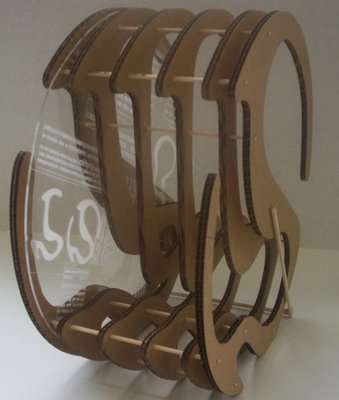
For this new assignment we were given the task to develop an enclosed space for one person to occupy. Mandi and I chose to study the ergo-dynamics of the design. We first approached the assignment at a basic level, defining what ergonomics is as well as material choice to allow the unit to be portable. Ergonomics is defined as an understanding of not only the physical interactions between a person and their surroundings but a psychological one as well. We first thought of the physical nature of someone in an enclosed space and a work area integrated into that. At the moment, some of our ideas seem a little confined and broad even, so we decided to analyze specific aspects of the design such as:
Adjustability/Versatility- the height of the useable interior space. How the positioning of one body can be altered to incorporate technology (audio, video, laptop, etc...). We researched the idea of static vs. dynamic body positions. We thought about possibly configuring an opening or a surface that would restrict a persons movement, versus having a surface that would allow a series of body positions. For construction in the interior space, a series of contours could be stacked vertically and covered in a skin, which has the possibly of being fixed or rotated to create a different position or offer veriability.


Another idea is that the contours could be slid or shifted in a horizontal direction which could be tightened into place. To achieve a static, but comfortable position, a solution is to construct a "
kneeling chair," which is minimal, eliminates stress when sitting for long periods of time, and could easily be combined with the other components of the booth.
Materials- this concept effects the weight and mobility of the unit, level of comfort inside, controlling the amount of noise/noise barriers, supporting the body, defining the space, and impacting the occupant on a visual level. Materials we found that would accommodate the body, be lightweight, and serve as some sort of insulation are: foam creations, which allow for versatility of shape, size, light;
inflatable plastic is another light idea that is easily adaptable, such as bubble wrap. We could mass produce small inflatable bubbles that can be shaped in any way in the portable unit, or the unit itself could be created with a system of
inflatable structures. We also thought of making three variations of this that would accommodate three different body sizes. These three "packages" could be zipped up and stored inside the unit. This also follows the idea of portablity. We thought that this thing could be deflated and packaged for ease of mobility and inflated in another place.
Psychological effects- ergonomic design determines not only body positions, but comfort sensation, and perception. Elements as simple as choice of material color or smell can effect the mood and performance of a person.
Color psychology can be used in combination with
aromatherapy to heighten the senses and productivity. For example, red hues are said to increase bodily tension and stimulate the autonomic nervous system and cool hues are said to release tension. Aromatherapy can be an alternative of medicine because of its psychology of odors and their effects on the mind. Studies show that the oils of certain plants have stimulating or relaxing effects. Blends are 100% natural and can do things from enhanceing memory and concentration to relieving stress.
These are all a combination of ideas we've explored and would like to incorporate into the design process
















 The egg will be locked into place and zipped into the box from the inside by the person, then he or she can turn around and have a conversation with someone else on the video screen with no outside distractions. We chose to take the idea of inflation and apply it to both the outside of the box and the inside of the egg. The air bubbles will penetrate the exterior surface of the box, creating an appealing surface that pushes the idea of comfort from the inside to the outside. We see others wanting to experience the surface and even lean on it if they desire. The inside of the box will allow for two different seating positions: one lying in the egg shape and another sitting at the edge of the egg seat with the weight of the person distributed to the knees, relieving tension from the lower back. While sitting on this kneeling chair, the pod can be unzipped, leaving an opening for group communication.
The egg will be locked into place and zipped into the box from the inside by the person, then he or she can turn around and have a conversation with someone else on the video screen with no outside distractions. We chose to take the idea of inflation and apply it to both the outside of the box and the inside of the egg. The air bubbles will penetrate the exterior surface of the box, creating an appealing surface that pushes the idea of comfort from the inside to the outside. We see others wanting to experience the surface and even lean on it if they desire. The inside of the box will allow for two different seating positions: one lying in the egg shape and another sitting at the edge of the egg seat with the weight of the person distributed to the knees, relieving tension from the lower back. While sitting on this kneeling chair, the pod can be unzipped, leaving an opening for group communication.




